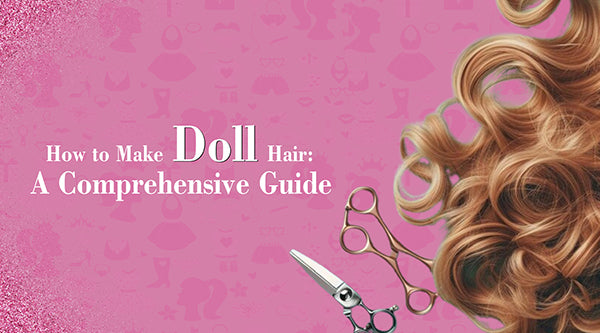Creating doll hair can be a fun and rewarding project. If you're looking to give an old doll a new look or create a unique style for a new one, this guide will walk you through the process step by step. Using various materials and techniques, you can craft beautiful and realistic doll hairstyles that will bring your dolls to life. This technique is specific to fashion dolls or dolls that have factory rooted doll hair. The method is called rerooting, or in some countries, it’s spelled rerouting.
Materials Needed for Making Doll Hair

Before you start, gather all the necessary materials. Here are some common items you might need:
- Yarn, Polypropylene, Kanekelon (not great to work with, but cheap and easy to find)
- Synthetic hair like Nylon or Saran (Much higher quality doll hair)
- Glue
- Scissors
- Rerooting Needles
- Doll head
Step-by-Step Guide to Making Doll Hair

1. Choosing the Right Material
The first step is selecting the material for your doll's hair. Yarn and synthetic hair are popular choices. Yarn, Polypropylene and Kanekelon are easy to find cheap and easy to work with and come in various colors. Although these types of doll hair materials are often used for rerooting, they look cheap, feel cheap and have many issues.
For higher quality synthetic hair that offers a more realistic look, that can be styled easily, and for a soft feel, most serious rerooters use high quality doll grade nylon. One of the huge appeals to nylon is that it holds a curly really easily, and comes in a variety of sheens from matte, low sheen, mid sheen, metallic shimmer, solar changing, temperature changing, glow in the dark, and is also available in many textures like pre-curled, crimped, s-curl (afro), micro braids and straight. Saran is also very popular for restoring vintage Barbie and Integrity dolls. Saran has very thin strands, feels waxy or greasy, and requires styling aids like gel or spray for long term hold. The appeal for saran is the natural matte look and detailed styles due to the thin fiber. Saran is also much easier to use for the knot rerooting method since the hair plugs feed through the eye of a needle easily.
2. Preparing the Doll Head
- Remove any existing hair from the doll head by cutting it completely off.
- Put the head into hot water or wrap in a heating pad and carefully remove the head without breaking the neck peg.
- Use forcep pliers to remove the hair stubs and glue through the neck hole.
- Clean the head surface thoroughly with acetone, nail polish remover or rubbing alcohol.
- Paint the head where the hair will be rerooted, a similar color to the hair you will be using. Then seal the acrylic paint with a finishing spray or glue sealer.
- If you are working on a head that is fragile or prone to splitting, add a couple of layers of liquid fusion to strengthen the scalp from splitting.
3. Creating the Hair Strands
Cut the doll hair material into appropriate lengths. Determine the length you want for your doll’s style and cut it twice the length you want for your style. The hair will be folded in half when using a rerooting tool method, pushing in hair plugs. For rerooting with the knot method you will want the hair to be about 1 inch longer than the desired hair style to accommodate for making the knot. For the purpose of this article, we will assume that you will be using the rerooting tool method, folding the hair in half and pushing in hair plugs.
This is a good time to lay out several hair plugs. You can wet your hair and use your fingers to pinch off and lay out several hair plugs. It is generally recommended to keep the hair plugs thin, around 7-10 strands. The plug must easily fit inside a rerooting needle that has an eye that is cut at an angle. If the plug is too thick, it will expand the needle which will cause rerooting needles to easily break. Most heads require 300 or more hair plugs. Thin plugs add up over time and make into a really nice thick head of hair for styling.
4. Attaching the Hair
Using a rerooting tool with a cut rerooting needle, you will wrap the hair plug around your finger and gently scoop up the center of the hair looped around your finger with your rerooting needle. Secure the hair so that it holds in place on the needle. Push the plug into the doll’s head, and pull the tool smoothly back out. The hair plug should stay inside the hole, and now you can repeat this process until the head has been completely rerooted.
It is important to note that on hairlines and partlines, you will want the needle to be in a perpendicular direction to the line. This will prevent the hairline and partline from splitting or cracking open.
It is also important to note that some doll heads can be hard to reroot if they have a firm head. Doll’s like Bratz, Integrity, Tonner, Gene, Fashion Royalty, Disney Animator, and others will need an additional step to make your needles last longer. You can use a thumb tac or awl to pre-punch the hole. Push in your tac or awl, prepare your plug, remove the tac or awl and push in your hair plug. This method will expand the hole. After about 20-30 minutes, the hole should shrink back down. You can also use hot water, a heat gun, hair dryer or heating pad to soften harder heads. Experiment and find the method for softening the head that you enjoy using for rerooting hard heads.
5. Sealing the hair before styling
Now that your hair has been rerooted you might be excited to style it. But wait! First you must seal the roots with glue. Fabri-Tac and Galaxy glue are commonly used and create a strong bond to all synthetic doll hair. Squeeze some glue through the neck, use a stick to push the glue evenly into the hair plugs. Wait 24 hours for the glue to completely cure before styling. Test a little area of the hair to make sure it has a strong hold and is not pulling out. If too much glue was used, the glue will not dry properly. You will need to scrap out excess glue if this happens.
Also Read: What is Barbie Hair Made Of?
Different Doll Hairstyles You Can Create
1. Simple Ponytail
Gather the hair into a high ponytail and secure it with a small elastic band. Ensure the ponytail is tight and smooth. Trim the ends of the hair for a neat and polished look. This classic style is easy to achieve and maintain.
2. Braided Styles
Braiding doll hair adds a charming touch. You can create simple three-strand braids or experiment with more intricate styles like fishtail or French braids. Secure the ends with small bands or ribbons. Braids can add both elegance and playfulness to your doll's look.
3. Curly Hair
Use small rods or straws to curl the hair. Wrap sections of the hair around the rods, secure them and apply gentle heat if using synthetic hair. Pour hot water over the hair, then run under cold water, then let air dry. Leave the hair to set and then carefully remove the rods once the hair is cool and dry. This creates bouncy, voluminous curls.
Be careful not to use high heat to avoid damaging the fibers. Most synthetic doll hair fiber can handle temperatures between 100-190 degrees fahrenheit. It is a good idea to test a small amount of your doll hair to make sure your heat setting doesn’t cause any damage.
4. Straight Hair
For a sleek look, pour hot water over the hair to reduce volume and to remove curves and waves in the hair. This style gives the doll a neat and sophisticated appearance.
Be careful not to use high heat to avoid damaging the fibers. Most synthetic doll hair fiber can handle temperatures between 100-190 degrees fahrenheit. It is a good idea to test a small amount of your doll hair to make sure your heat setting doesn’t cause any damage.
Advanced Techniques for Doll Hair
1. Making a Doll Wig
Creating wigs for dolls allows you to change hairstyles for dolls easily. Measure the doll's head and create a wig cap using fabric. Attach the hair strands to the wig cap and style as desired.
2. Hair for rerooting dolls
Rerooting involves implanting (rerooting) hair into the doll's head. Use a rerooting tool to insert individual strands of synthetic hair, securing them with glue.
Maintaining Your Doll's Hair
1. Washing and Conditioning
Wash synthetic doll hair with mild shampoo (liquid dish soap) and conditioner (liquid fabric softener). Rinse thoroughly and let it air dry.
2. Styling and Detangling
Use a wide-tooth comb or fine-tooth comb to detangle the hair gently. Avoid using heat styling tools frequently, as they can damage synthetic hair. Warm or hot water is usually safer than electric styling tools.
Creative Ideas for Doll Hairstyles
1. Adding Accessories
Improve your doll's hairstyle with accessories like ribbons, bows, and hair clips.
2. Dyeing Doll Hair
Experiment with coloring synthetic hair using Rit Dyemore or IDye-Poly. Follow the instructions carefully to achieve the desired shade.
Creating (rerooting) doll hair is an enjoyable and creative process. With the right materials and techniques, you can give your dolls beautiful, lifelike hairstyles. If you're using yarn hair or rerooting synthetic hair, each method offers unique results.
Ready to change your dolls with beautiful new hairstyles? Visit Doll Planet and explore our collection of hair materials and styling tools! Unlock your creativity today!
FAQs
-
What can I use to make doll hair?
You can use yarn, synthetic hair, or even natural fibers like wool to make doll hair.
-
What is doll hair made of?
Doll hair can be made of various materials, including synthetic fibers, like nylon, saran, nylon silk, mono fiber, polypropylene and kanekalon..
-
How do dolls get hair?
Doll hair is typically attached through methods like sewing, gluing, or rerooting individual strands into the doll's head.
-
How to make doll hair straight?
DON’T use a straightening iron unless you know it has a low heat setting for synthetic hair. Hot water is recommended for most types of synthetic doll hair.
-
How to use yarn for doll hair?
Cut the yarn into strands, fold them in half, and sew or glue them onto the doll's head for a full, voluminous hairstyle.
Also Read: How to Detangle Doll Hair

